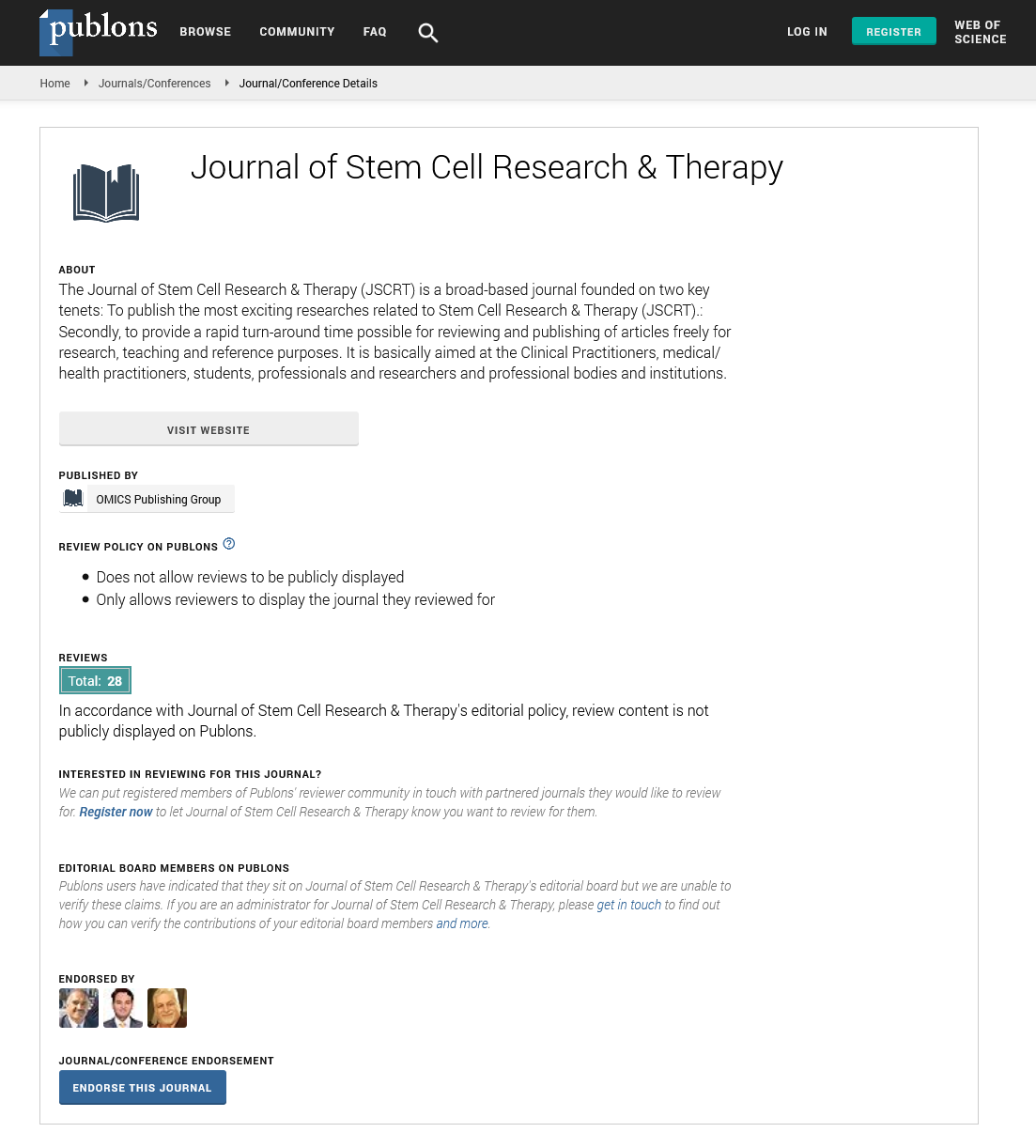Indexed In
- Open J Gate
- Genamics JournalSeek
- Academic Keys
- JournalTOCs
- China National Knowledge Infrastructure (CNKI)
- Ulrich's Periodicals Directory
- RefSeek
- Hamdard University
- EBSCO A-Z
- Directory of Abstract Indexing for Journals
- OCLC- WorldCat
- Publons
- Geneva Foundation for Medical Education and Research
- Euro Pub
- Google Scholar
Useful Links
Share This Page
Journal Flyer

Open Access Journals
- Agri and Aquaculture
- Biochemistry
- Bioinformatics & Systems Biology
- Business & Management
- Chemistry
- Clinical Sciences
- Engineering
- Food & Nutrition
- General Science
- Genetics & Molecular Biology
- Immunology & Microbiology
- Medical Sciences
- Neuroscience & Psychology
- Nursing & Health Care
- Pharmaceutical Sciences
Perspective - (2023) Volume 13, Issue 3
The Development of Tissue Regeneration in Current Healthcare
Savannah Delgado*Received: 29-Apr-2023, Manuscript No. JSCRT-23-21572; Editor assigned: 02-May-2023, Pre QC No. JSCRT-23-21572(PQ); Reviewed: 17-May-2023, QC No. JSCRT-23-21572; Revised: 24-May-2023, Manuscript No. JSCRT-23-21572(R); Published: 01-Jun-2023, DOI: 10.35248/2157-7633.23.13.598
Description
In recent years, the field of tissue regeneration has witnessed remarkable advancements, revolutionizing the way it approach healthcare. Tissue regeneration refers to the restoration of damaged or lost tissues, organs, or limbs through the activation of the body's innate regenerative mechanisms or the application of cutting-edge techniques. This groundbreaking area of research holds immense potential for addressing various medical conditions, from degenerative diseases to traumatic injuries. By harnessing the body's remarkable ability to heal itself, tissue regeneration offers a transformative approach that may surpass traditional treatments, such as transplantation or prosthetic devices. In this, explore the exciting prospects of tissue regeneration, the challenges it presents, and the ethical considerations that arise with its implementation.
Tissue regeneration holds enormous promise in revolutionizing modern medicine and addressing some of the most challenging medical conditions. One key aspect of tissue regeneration is the potential to restore damaged tissues or organs without the need for invasive procedures or transplants. This approach can significantly improve patient outcomes, reduce healthcare costs, and alleviate the burden on organ transplantation waiting lists. In the realm of regenerative medicine, stem cells play a vital role. These versatile cells possess the unique ability to differentiate into various cell types, making them a valuable resource for tissue repair and regeneration. Stem cell-based therapies have shown great potential in treating conditions such as spinal cord injuries, heart disease, and neurodegenerative disorders. By directing the differentiation of stem cells, scientists can guide tissue regeneration, fostering the growth of functional tissues and organs. Furthermore, tissue engineering and 3D bio printing are emerging technologies that enable the fabrication of complex tissues and organs using biomaterials and patientspecific cells. This approach allows for the creation of personalized tissues, minimizing the risk of rejection and increasing compatibility. The ability to bio fabricates tissues and organs could revolutionize transplantation, as it may eliminate the need for donors and reduce the ethical concerns associated with organ procurement.
While tissue regeneration offers tremendous promise, it also presents several challenges and ethical considerations that must be addressed. One of the primary challenges is achieving functional integration of regenerated tissues with the existing anatomy. The complexity of tissues and their intricate connections require careful engineering to ensure proper functionality. Researchers must develop strategies to promote vascularization, innervation, and integration of regenerated tissues with the host environment. Another significant hurdle is the scalability and affordability of tissue regeneration therapies. As with any new technology, initial costs can be prohibitive, limiting access to those who need it most. Widespread adoption of tissue regeneration will require concerted efforts to optimize production processes, reduce costs, and develop regulatory frameworks that ensure safety and efficacy. Ethical considerations also arise in the context of tissue regeneration. The use of embryonic stem cells raises ethical debates due to concerns surrounding the destruction of embryos. However, advancements in induced Pluripotent Stem Cells (iPSCs) have offered a potential solution, as these cells can be generated from adult cells without the need for embryos. IPSCs provide an ethically acceptable alternative while maintaining the regenerative potential of stem cells. Additionally, questions regarding equity and access to tissue regeneration therapies need careful consideration. As with many medical innovations, there is a risk of exacerbating healthcare disparities if these therapies become available only to a privileged few. Efforts must be made to ensure equitable access and affordability, allowing tissue regeneration to benefit all segments of society.
Tissue regeneration represents a paradigm shift in healthcare, offering the potential to restore damaged tissues and organs, improve patient outcomes, and reduce healthcare costs. Stem cell-based therapies, tissue engineering, and bio printing are among the key approaches driving this field forward. However, challenges related to functional integration, scalability, affordability, and ethical considerations must be addressed for tissue regeneration to fulfill its transformative potential. By promoting interdisciplinary collaborations, supporting further research, and fostering equitable access, and pave the way for a future where tissue regeneration becomes a mainstream treatment modality, benefitting individuals across the globe and revolutionizing the field of medicine.
Citation: Delgado S (2023) The Development of Tissue Regeneration in Current Healthcare. J Stem Cell Res Ther. 13:598.
Copyright: © 2023 Delgado S. This is an open-access article distributed under the terms of the Creative Commons Attribution License, which permits unrestricted use, distribution, and reproduction in any medium, provided the original author and source are credited.

